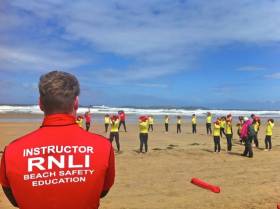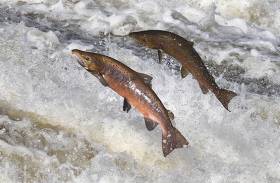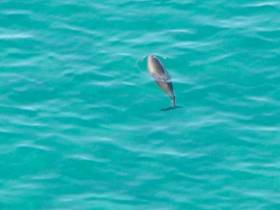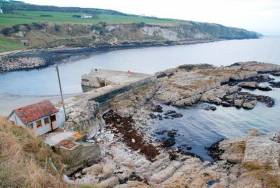Displaying items by tag: Northern Ireland
NI Coastguard Teams In Gobbins Cliff Rescue Exercise
#Coastguard - Northern Ireland coastguard teams have taken part in a major rescue exercise The Gobbins in Co Antrim ahead of the cliff path's reopening this May Day weekend, as the Belfast Telegraph reports.
As many as 50 volunteers from Kilkeel, Newcastle, Ballycastle, Coleraine and Portmuck carried out various cliff rescue exercises, including a mock evacuation of multiple casualties.
The path has undergone a number repairs after significant storm damage forced its closure in December, just months after the 'white-knuckle' attraction welcomed its first visitors since the 1950s.
The Belfast Telegraph has more on the story HERE.
Espey Backs 'Flow' Campaign For Watersports In Northern Ireland
#JamesEspey - Olympic Laser hopeful James Espey made time in his busy Rio 2016 training schedule for to help launch a new campaiign aimed at getting people involved in watersports, according to the News Letter.
As previously reported on Afloat.ie, the Flow campaign is a partnership between SportNI and various sporting bodies that's encouraging water-based activities in the run up to September's European Week of Sport.
Watersports clubs around Northern Ireland will be offering taster events on the weekend of 14-15 May to get things running, and Espey is fully behind the initiative.
"This new Flow campaign is absolutely ideal for those with no background in watersports whatsoever," said the Olympian who still trains where he first learned to sail at Ballyholme.
“It will be a fantastic introduction for anyone wanting to get into water based activities across Northern Ireland.”
The News Letter has more on the story HERE.
#Surfing - Surfers from across the North West paired up to take part in a unique event to raise money for mental health charity Aware NI last week.
The money raised at the tandem surfing competition, run by Portrush-based surfing school Troggs, will help Award NI provide vital services for people affected by depression across Northern Ireland.
Teams of surfers took to Portrush East Strand on Sunday 20 March to perform tricks and manoeuvres in pairs in an attempt to impress the experienced judges.
The tandem surfing competition, the first of its kind in Northern Ireland, raised over £300 (€372) for Aware NI.
The event was the brainchild of Carl Russell, owner of Troggs Surf School, after some of his own clients recommended the benefits of surfers in overcoming the own depression.
“The idea came about from my brother Jamie Russell and I realising that we could experience surfing together on the same board when surf conditions weren’t favourable for our shortboards,” he said.
“We ended up having as much fun if not more tandem surfing as we did surfing normally. Then the link for the competition was made to show that the proven research that surfing helps depression is a real tool that can be used."
Russell explained that surfing "has had positive effect on people and clients of ours with mental health issues which is why we have chosen this charity, plus this professional organisation really helps people.
"We run custom surf programmes for groups affected by the issues mentioned. Our event is due to run again September-October 2016 and will be even bigger.
“Thanks to all our sponsors gregwallace.co.uk, garymccall.co.uk, couconoutdoor.com, Brew Note Portrush & AC Electronics Coleraine.
Only last year the French seaside town of Biarritz become the first in the world to prescribe surfing lessons as a way to treat depression to heart disease.
Some 20 doctors are taking part in a pilot scheme in Europe’s surf capital to encourage the notoriously pill-popping French to cut back on medication and take to the waves.
“Aware fully endorse the message that physical exercise cannot only improve your physical health but also your mental health,” said Kieran Hughes, fundraising officer at Aware NI.
“The benefits of physical exercise for mental health are widely recognised and surfing is one of the best examples of that. Participants are getting excellent exercise but also getting out in the open and close to nature which can only be a positive thing.
“We would like to sincerely thank Carl and everyone at Troggs Surf School for raising money for Aware. All the money raised will go towards Aware’s Support Services and education programmes to help people affected by depression across Northern Ireland.”
#Lifeguards - RNLI lifeguards are hitting the surf again and bringing their popular beach safety programmes to school children and youth groups in Northern Ireland.
Hundreds of children have already been through the programmes and learned valuable and important advice to keep safe in the water and along the shore, in a fun and interactive way.
Last summer 345,027 people visited the 10 RNLI-lifeguarded beaches on the Causeway Coast and in Co Down. Of these people 27,043 entered the water while 9,975 took part in surfing or other water leisure actives such as body boarding and kite surfing.
The lifeguards responded to 182 incidents, coming to the aid of 218 people. As well as rescues carried out in the water, lifeguards also dealt with falls, first aid and lost children.
The RNLI lifeguarding season has already begun on five beaches along the Causeway Coast and this cover will be extended for the peak summer season from Saturday 25 June through to Sunday 4 September.
In the run up to this and before schools break up for the summer, the RNLI is encouraging primary schools and youth groups to sign-up for its two beach safety education programmes.
The ‘Meet the Lifeguards’ and ‘Hit the Surf’ programmes teach young people the importance of beach safety in a fun and practical way.’
‘Meet the Lifeguards’ is an interactive session where RNLI lifeguards visit a school or youth group and teach the children key safety advice that they then put to use when they visit a beach with family and friends.
Children learn what the different beach safety flags and signs mean, the safety of using inflatables, the dangers of 'tombstoning', sun safety and how to identify natural and man-made hazards in and around the water. They will also learn about body boarding and surfing safety and how to escape a rip current. Information on tides and waves is included in the session.
The ‘Hit the Surf’ programme, meanwhile, offers a unique opportunity for school children or youth groups to get practical lessons in lifesaving and beach safety at one of the 10 RNLI-lifeguarded beaches located on the North Coast and in Co Down, or inland for the first time on the shores of Lough Erne in Cp Fermanagh.
The two-and-a-half-hour session includes a lesson on staying safe at the beach and explains the role of the RNLI and its lifeguards. It is followed by a lifesaving lesson and learning surf-based skills while building the children’s confidence in the sea. They will also learn about local hazards and the beach environment.
For more information on how to book your school onto an RNLI education programme in Northern Ireland, contact RNLI lifeguard supervisor Jenny Thompson 077 8992 4563 or email [email protected]
New Statistics On Northern Ireland's Inland Fisheries
#Angling - Northern Ireland's Department of Culture, Arts and Leisure (DCAL) has published a digest of statistics for salmon and inland fisheries in the department's jurisdiction.
The main purpose of these statistics is to give an overview of the DCAL fisheries sector in Northern Ireland. The latest available data have been drawn together from a number of published and unpublished sources.
Some key statistics from the report include the following:
- There were 25,667 angling licences and 17,984 DCAL permits sold in 2014.
- 1,024 rod licences and 1,013 permits were checked in the DCAL public angling estate in 2014/15.
- There were approximately 361,000 salmon fry stocked from Bushmills Hatchery to rivers in Northern Ireland in 2014.
- No salmon were caught in commercial fishing nets in 2014.
- The estimated return of wild adult salmon to the River Bush in 2014 was 963 and was below the previous 10-year average (2004-2013) of 1,239.
- The 10-year overall eel catch average in Lough Neagh (2005-2014) of 399 tonnes is 35% less than the previous ten year eel catch average (1995-2004) of 612 tonnes.
- The eel escapement estimate for the Neagh-Bann River Basin District for 2014 was 253 tonnes and above the 200 tonnes target.
The bulletin is available on the DCAL website or from the Research and Statistics Branch, Department of Culture, Arts and Leisure, Causeway Exchange, 1-7 Bedford Street, Belfast BT2 7EG (Tel: 028 9081 6971; Email: [email protected]).
In other news, Northern Ireland's Culture, Arts and Leisure Minister Carál Ní Chuilín has welcomed a new platform designed to accommodate disabled anglers at Copeland Reservoir in Carrickfergus.
The concrete platform is built to a high specification and gives anglers who use wheelchairs close and safe access to the water.
“Angling is an integral part of our leisure offering not only for local people, but also for tourists," said the minister this week. "It is a very relaxing and peaceful way of passing time and unwinding in the open air, and I am committed to ensuring that wheelchair users have equal access to angling."
Minister Ní Chuilín said the new platform "is designed to ensure that wheelchair-using anglers can get as close as possible to the water’s edge, safely. There is also a car park located right beside it, further enhancing accessibility.
“There is a considerable disabled angling fraternity locally, with over 1,700 one-year disabled angling licences and 1,500 day permits being issued each year. This is a significant number, and I want to see even more disabled people experiencing the benefits of angling for themselves."
The new stand "offers disabled anglers another choice of location to fish, and visit the surrounding area. It brings to more than 30 the number of public angling estate locations which are accessible to anglers with a disability," the minister added.
“I commend staff in my department’s Inland Fisheries Group who have constructed the platform and I hope that it caters for disabled anglers for many years to come.”
#MarineWildlife - Dolphin and porpoise monitoring off the North Coast got a boost this week thanks to a £15,000 NI government grant for the Irish Whale and Dolphin Group (IWDG), as Causeway Coastal Community reports.
“This is good news for the IWDG and for those with a passion for marine wildlife," said Northern Ireland's Environment Minister Mark Durkan on funding for the acoustic monitoring project, which will focus on cetacean populations off Portrush and the nearby Giant's Causeway.
The project also includes an outreach programme with local schools and communities to get local people invested in the protection of marine wildlife on their shores. Causeway Coastal Community has more on the story HERE.
Minister Durkan is also the subject of calls to add the waters off Islandmagee to recently recommended Marine Conservation Zones for Northern Ireland over fears that a new gas power station could create a marine 'dead zone' in the area.
#MarineWildlife - Islandmagee locals are appealing to Northern Ireland's Environment Minister to add their waters to the list of recently proposed Marine Conservation Zones.
As the Belfast Telegraph reports, the call comes over fears that a planned Gaelectric gas power station could create a 'dead zone' in the North Channel caused by brine runoff from the plant.
Gaeletric maintains that even under a worst-case scenario, any impact of brine pumped into the sea on marine wildlife and plantlife would be low.
But the Islandmagee Community Residents Association argues that the development poses a threat to a "delicate and biodiverse" ecosystem in the area, which is home to vulnerable colonies of puffins as well as black guillemots and razorbills, among others.
As reported in December on Afloat.ie, Rathlin, Waterfoot, Outer Belfast Lough and Carlingford Lough were put forward for consideration as Marine Conservation Zones, the public consultation for which closed last Friday 11 March.
The Belfast Telegraph has more on the story HERE.
Northern Lights Shimmer Over Belfast & Lough Neagh
#Aurora - Skywatchers in Northern Ireland were treated to a spectacular light show last night (Monday 7 March) as a "lucky combination" of weather conditions made the aurora borealis visible across much of the country.
The video below, via Tam Mullen and the Belfast Telegraph, shows how the Northern Lights looked over Belfast and Lough Neagh.
Newcastle Lifeboat Rescues Four After Angling Boat Gets Into Difficulty
#RNLI - Newcastle RNLI rescued four people on Saturday night (13 February) after their angling boat got into difficulty off the Co Down coast.
The volunteer crew were requested to launch their all-weather lifeboat at 7.30pm on Saturday following a request from Belfast Coastguard to go to the aid of a 36ft angling boat, which had suffered engine failure eight miles south east of St John’s Point while on passage from Howth to Carrickfergus.
Under coxswain Aidan Riley and with five crew members on board, the lifeboat launched within minutes and made its way to the scene some 16 nautical miles from the station.
Weather conditions at the time were described as fresh with rough seas and Force 5-6 winds blowing.
With the vessel losing battery power, Newcastle RNLI advised the crew to switch the boat’s lights off until the lifeboat was closer to their location.
Once on scene 80 minutes later, the lifeboat crew assessed the situation and once confident that no one was in any immediate danger, the lifeboat crew began to work with the angling crew to set up a towline.
The vessel was then taken under tow and brought safely back to Ardglass.
Speaking following the callout, Newcastle RNLI coxswain Aidan Riley said: "The vessel was quite a bit away from the shore when it sustained engine difficulties and the crew made the right call to ask for assistance.
"We were delighted to help and glad to see the boat and her crew returned safely to Ardglass."
Surf's Up For Award-Winning North Coast
#NorthCoast - Ireland's North Coast – one of the island's emerging surfing hotspots – was the big winner at the 2016 OutdoorNI Awards, as the Coleraine Times reports.
A third of the accolades presented on the night went to activities and locations around the Portrush coastal region, as voted on by the public.
Among them was the song for Best Coastal Experience, awarded to Troggs surf school in Portrush – while the Causeway Coast & Glens was named Best Adventure Destination for its abundance of opportunities not just for surfing and sea kayaking but also hiking and coasteering.
The Coleraine Times has more on the story HERE.





































































